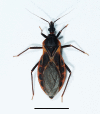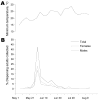Infection of kissing bugs with Trypanosoma cruzi, Tucson, Arizona, USA
- PMID: 20202413
- PMCID: PMC3322010
- DOI: 10.3201/eid1603.090648
Infection of kissing bugs with Trypanosoma cruzi, Tucson, Arizona, USA
Abstract
Triatomine insects (Hemiptera: Reduviidae), commonly known as kissing bugs, are a potential health problem in the southwestern United States as possible vectors of Trypanosoma cruzi, the causative agent of Chagas disease. Although this disease has been traditionally restricted to Latin America, a small number of vector-transmitted autochthonous US cases have been reported. Because triatomine bugs and infected mammalian reservoirs are plentiful in southern Arizona, we collected triatomines inside or around human houses in Tucson and analyzed the insects using molecular techniques to determine whether they were infected with T. cruzi. We found that 41.5% of collected bugs (n = 164) were infected with T. cruzi, and that 63% of the collection sites (n = 22) yielded >or=1 infected specimens. Although many factors may contribute to the lack of reported cases in Arizona, these results indicate that the risk for infection in this region may be higher than previously thought.
Figures


References
-
- Pan American Health Organization Estimación cuantitativa de la enfermedad de Chagas en las Américas. 2006. [cited 2010 Jan 12]. http://www.bvsops.org.uy/pdf/chagas19.pdf
-
- Tropical Disease Research, World Health Organization. Insect vectors and human health. Report of the scientific working group meeting. Geneva. Organization. 2003;23–5.
-
- World Health Organization. Chagas disease [cited 2010 Jan 12]. http://www.who.int/tdrold/diseases/chagas/default.htm.2004
-
- Grant IH, Gold J, Wittner M, Tanowitz H, Nathan C, Mayer K, et al. Transfusion-associated acute Chagas disease acquired in the United States. Ann Intern Med. 1989;111:849–51. - PubMed
-
- Nickerson P, Orr P, Schroeder M-L, Sekla L, Johnston J. Transfusion-associated Trypanosoma cruzi infection in a non-endemic area. Ann Intern Med. 1989;111:851–3. - PubMed
Publication types
MeSH terms
Substances
LinkOut - more resources
Full Text Sources
Medical
